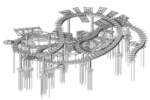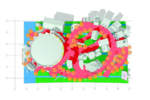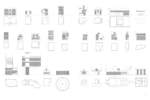architect: John Körmeling
location: expo 2010 shanghai - zone C
year: 2010
“Better City, Better Life”, the theme of the expo 2010, origins in a good street. A street mixed with different types of buildings like a house, a shop, a factory, an office, a farm, a petrol station, a sportfield, a garage, forms the condition for a social life. The World Expo is a centre for pleasure and amusent/education. So the Dutch pavilion is like a walkable rollercoaster with buildings hanging on it like apples on a tree. In each building along the road, there is an invention, a sculpture or a secret which makes life more joyful. New ways of energy, growing food or purifacation of water. I want to make an open pavilion with no door. The interior is outside.
John Körmeling was born in Amsterdam and graduated from Eindhoven Polytechnic in architecture and urban planning in 1980. Early in his career he became dissatisfied with small-minded systems and the constrictive practices of traditional and much of modern architecture, urban planning and art. His primary focus has been to circumvent systemic limitations and he has struggled to liberate space by creating solutions with a sudden and resonant impact.
Since 1981, Körmeling has designed and/or built an amazing array of objects and ingenious installations with an emphasis on light and lightweight solutions. One of his first recorded projects at De Appel, in 1983, focused on liberating space with light, when he presented an interactive installation, Ontwerpmachine (Designing Machine). By exposing phosphorescent filaments and small Styrofoam balls to three-minute doses of artificial light, he demonstrated how the largely ephemeral materials would reveal, in the alternating periods of darkness, the existing space within a new space of phosphorous green. Another project, at the Apollohuis in Eindhoven, was the sculpture Hangen en staan (Hanging and Standing). For this project, Körmeling shot a beam of light through the building, from the basement to the attic, using a series of holes in the foundation and carefully positioned mirrors to reflect the laser’s beam. His large-scale neon birthday signs on buildings (Kop van Zuid, Rotterdam, 1989), his electric light shining through miniature-scale faux storm clouds onto a sunbather (Gat in de Wolk – Hole in the Cloud, Madurodam, Den Haag, 1989), or his long awaited Theehuis (Tea Shop) in Valkenberg Park, central Breda, 2002 – these and other projects showcase again and again the way he breaks design open, creates space and remarkable flashes of beauty by a process of subtraction and the use of light to engage the viewer.












